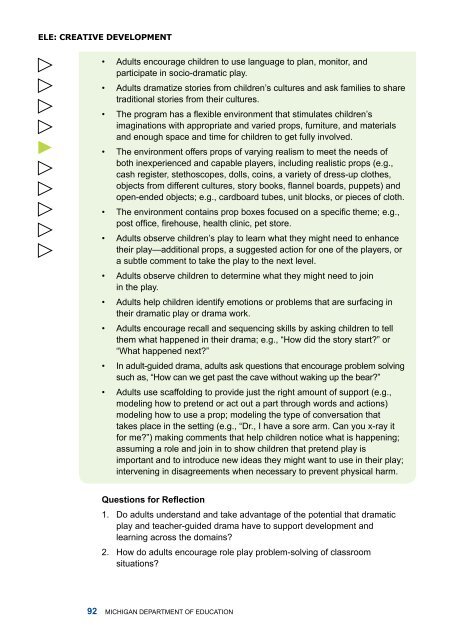Early Childhood Standards of Quality for ... - State of Michigan
Early Childhood Standards of Quality for ... - State of Michigan
Early Childhood Standards of Quality for ... - State of Michigan
You also want an ePaper? Increase the reach of your titles
YUMPU automatically turns print PDFs into web optimized ePapers that Google loves.
ELE: Creative Development• Adults encourage children to use language to plan, monitor, andparticipate in socio-dramatic play.• Adults dramatize stories from children’s cultures and ask families to sharetraditional stories from their cultures.• The program has a flexible environment that stimulates children’simaginations with appropriate and varied props, furniture, and materialsand enough space and time <strong>for</strong> children to get fully involved.• The environment <strong>of</strong>fers props <strong>of</strong> varying realism to meet the needs <strong>of</strong>both inexperienced and capable players, including realistic props (e.g.,cash register, stethoscopes, dolls, coins, a variety <strong>of</strong> dress-up clothes,objects from different cultures, story books, flannel boards, puppets) andopen-ended objects; e.g., cardboard tubes, unit blocks, or pieces <strong>of</strong> cloth.• The environment contains prop boxes focused on a specific theme; e.g.,post <strong>of</strong>fice, firehouse, health clinic, pet store.• Adults observe children’s play to learn what they might need to enhancetheir play—additional props, a suggested action <strong>for</strong> one <strong>of</strong> the players, ora subtle comment to take the play to the next level.• Adults observe children to determine what they might need to joinin the play.• Adults help children identify emotions or problems that are surfacing intheir dramatic play or drama work.• Adults encourage recall and sequencing skills by asking children to tellthem what happened in their drama; e.g., “How did the story start?” or“What happened next?”• In adult-guided drama, adults ask questions that encourage problem solvingsuch as, “How can we get past the cave without waking up the bear?”• Adults use scaffolding to provide just the right amount <strong>of</strong> support (e.g.,modeling how to pretend or act out a part through words and actions)modeling how to use a prop; modeling the type <strong>of</strong> conversation thattakes place in the setting (e.g., “Dr., I have a sore arm. Can you x-ray it<strong>for</strong> me?”) making comments that help children notice what is happening;assuming a role and join in to show children that pretend play isimportant and to introduce new ideas they might want to use in their play;intervening in disagreements when necessary to prevent physical harm.Questions <strong>for</strong> Reflection1. Do adults understand and take advantage <strong>of</strong> the potential that dramaticplay and teacher-guided drama have to support development andlearning across the domains?2. How do adults encourage role play problem-solving <strong>of</strong> classroomsituations?92 <strong>Michigan</strong> Department <strong>of</strong> Education


